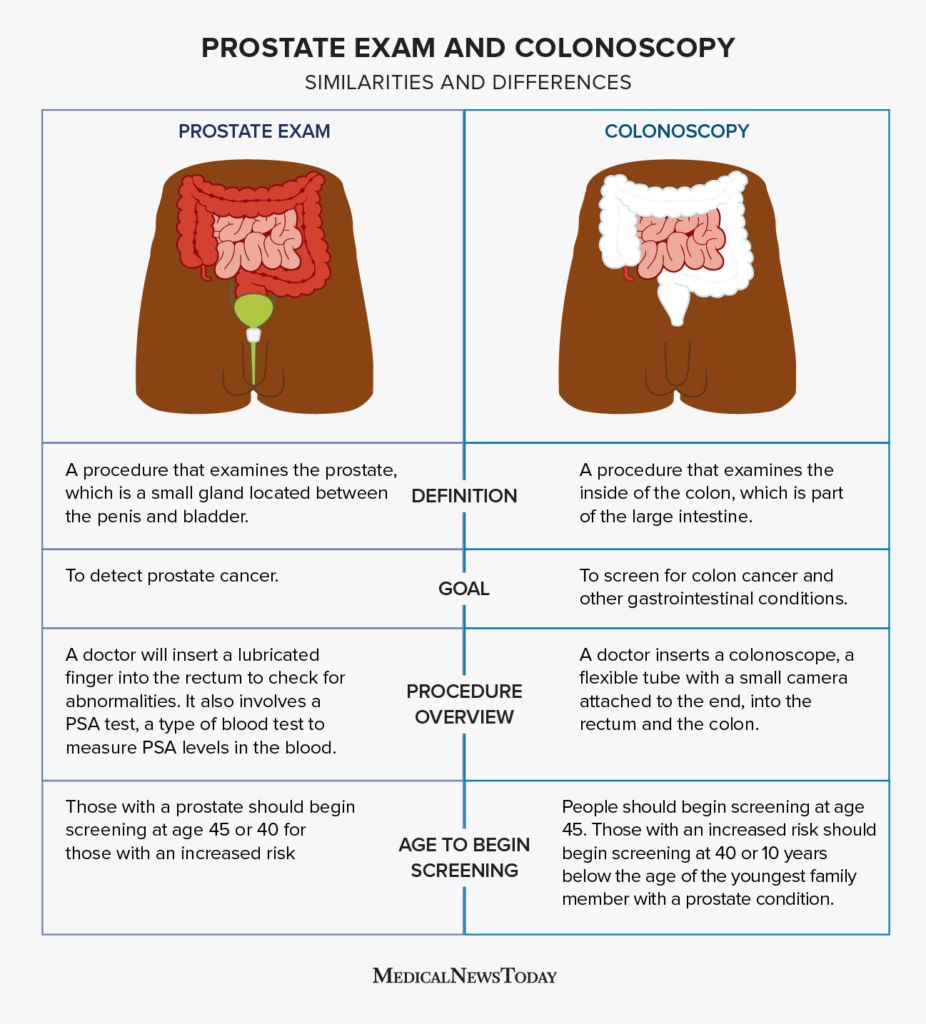A prostate exam is a procedure that helps screen for prostate cancer in people who have a prostate gland. A colonoscopy is a procedure that helps screen for colon cancer and other gastrointestinal diseases.
This article defines what a prostate exam and a colonoscopy are and explains the purpose of each procedure.
It also outlines who should receive each procedure, what each involves, and their screening guidelines. Finally, it answers some frequently asked questions about prostate exams and colonoscopies.

A prostate exam is a medical procedure to screen for prostate cancer. Prostate exams are only for people who have a prostate since people without a prostate cannot develop prostate cancer.
According to the Prostate Cancer Foundation (PCF), the exam may involve two tests: a prostate-specific antigen (PSA) test and a digital rectal examination (DRE).
PSA test
The prostate produces a protein called PSA. According to the
A PSA test measures levels of PSA in the blood. Typically, higher levels of PSA indicate an increased likelihood of prostate issues.
The
DRE
The DRE is a physical examination in which a doctor inserts a lubricated finger into the rectum to check for abnormalities with the prostate gland.
DREs are
According to the American College of Gastroenterology (ACG), a colonoscopy is a procedure that allows doctors to view and examine the colon. It can help in diagnosing a range of gastrointestinal (GI) disorders, including colon cancer and colon polyps.
A colonoscopy involves inserting a long, flexible tube or “colonoscope” into the rectum and up into the colon. The tube has a camera attached, allowing doctors to view the entire length of the colon.
Colonoscopies are for both sexes since males and females have an equal risk of developing colon cancer.
A prostate exam and a colonoscopy can help doctors diagnose conditions in different parts of the body.
Prostate exam
A prostate exam can help doctors screen for and diagnose prostate cancer or other prostate conditions.
Colonoscopy
According to the ACG, a colonoscopy can help doctors diagnose a range of gastrointestinal (GI) disorders, including:
- colon cancer
- colon polyps
- diverticulitis
- inflammatory bowel disease
- intestinal obstruction
Below is the procedure for prostate exams versus colonoscopies.
Prostate exam
To perform a prostate exam, a doctor inserts a gloved, lubricated finger into the rectum to check for abnormalities on the prostate.
Due to the positioning of the prostate, the doctor will only be able to detect abnormalities toward the back of the prostate gland. However, prostate cancers
A prostate exam can be uncomfortable, particularly for individuals who have hemorrhoids. However, the exam should not be painful.
Colonoscopy
A colonoscopy involves inserting a colonoscope into the rectum and up into the colon.
A camera attached to the colonoscope allows doctors to view the entire length of the colon and assists them in making a diagnosis.
If necessary, doctors can insert specialist instruments into the colonoscope to take biopsies or remove colon polyps, which could otherwise develop into cancer.
The following outlines the screening guidelines for prostate exams and colonoscopies.
Prostate exam
The PCF recommends individuals with a prostate begin prostate screening at age 45, while individuals with an increased risk of developing prostate cancer begin screening earlier at age 40.
Colonoscopy
The ACG recommends everyone receive their first colonoscopy screening at age 45.
For individuals at increased risk of developing colon cancer, the ACG recommends colonoscopy screenings starting at age 40, or 10 years before the age of their youngest family member developed colon cancer — whichever is earliest.
Below are some answers to frequently asked questions about prostate exams and colonoscopies.
Can a colonoscopy detect prostate problems?
A colonoscopy cannot detect issues with the prostate. However, an older
Can a colonoscopy include a prostate exam?
Before inserting the camera for a colonoscopy, doctors typically perform a DRE on everyone undergoing the procedure to check for any potential lesions, masses, or atypical anatomy. If the person receiving the colonoscopy is male, the doctor
Which is more accurate for prostate cancer?
A prostate exam is a more accurate method for detecting prostate cancer.
The exam consists of two assessments: PSA testing and a DRE. Of these two assessments, PSA testing is the most accurate test for prostate cancer. However, DREs can sometimes detect prostate cancer in individuals with normal PSA levels.
A prostate exam helps detect prostate cancer in people who have a prostate gland, while a colonoscopy helps detect colon cancer and other gastrointestinal (GI) conditions in both males and females.
A prostate exam may include two procedures — a prostate-specific antigen (PSA) test and a digital rectal examination (DRE). A colonoscopy involves using a colonoscope to view the inside of the colon. Doctors may sometimes perform a DRE before a colonoscopy, especially if the person has a prostate gland.
Most people with a prostate should begin prostate screening at age 45, whereas both men and women should receive their first colonoscopy at age 45. Individuals with risk factors for either disease should begin the appropriate screening procedure at age 40 or younger. A person can talk with a doctor if they require further advice about prostate or colonoscopy screening.
